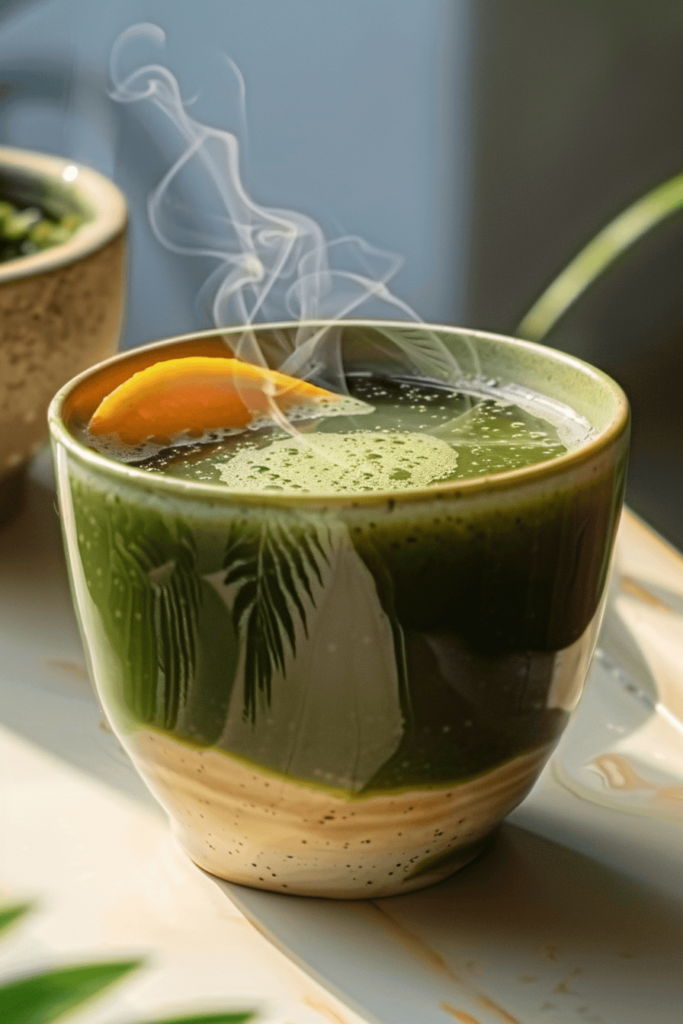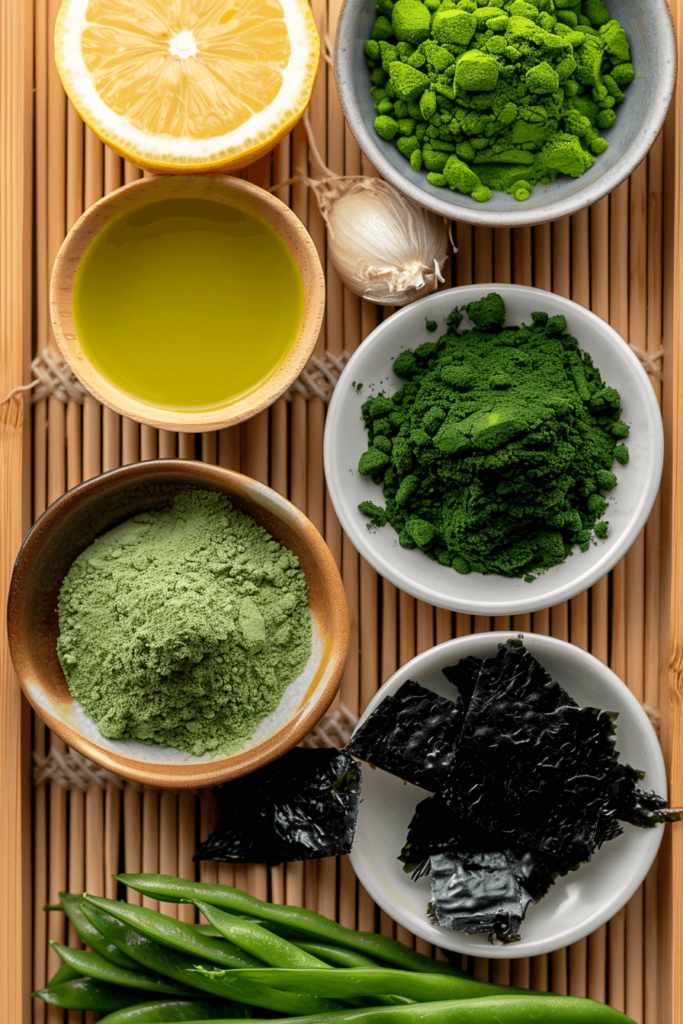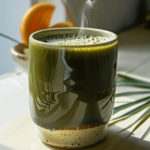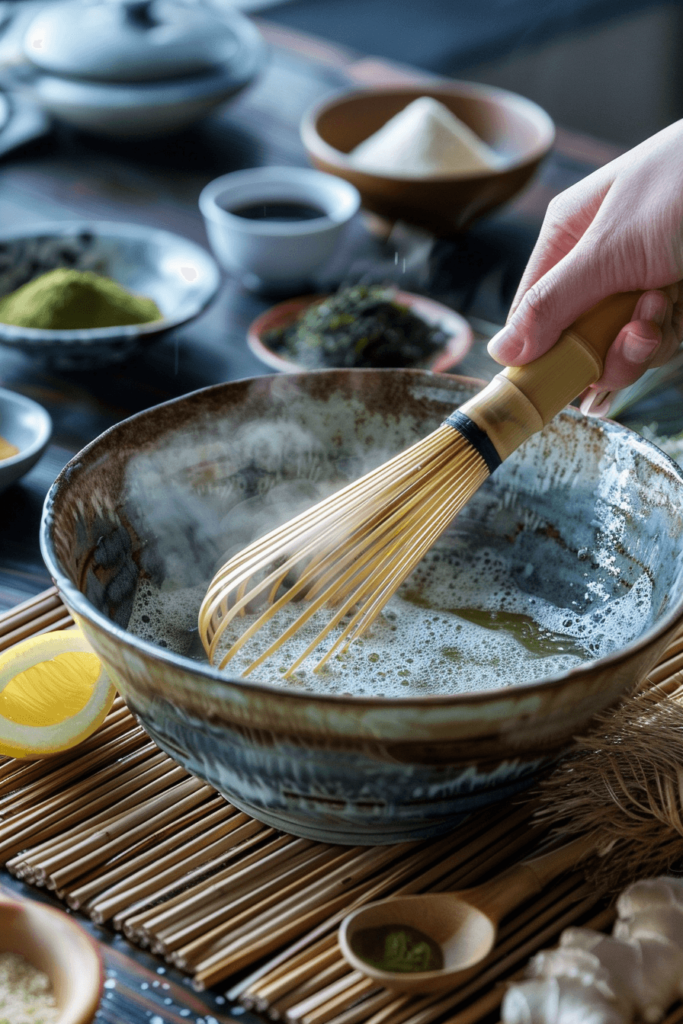If you’ve ever dreamed of sipping your way to a flatter belly while feeling like a wise monk on a mountaintop, then the Japanese Mounjaro recipe might just be your new obsession. Rooted in centuries-old Japanese wellness traditions but freshly wrapped in modern weight loss buzz, this natural drink doesn’t come in a prescription bottle—it comes in a bowl, a bottle, or even a teacup.

While TikTok is flooded with fast fixes and fat-burning fads, the Japanese Mounjaro recipe quietly gained traction for one simple reason: it works. No injections, no pharmacy visits—just a handful of natural ingredients known to curb appetite, boost metabolism, and make you feel like you’ve already conquered your cravings.
Let’s break it all down and find out how this ancient Japanese blend became the go-to choice for health lovers across the U.S.
Table of Contents
The Rise of the Japanese Mounjaro Recipe
What is the Japanese Mounjaro recipe and why is it trending?
The Japanese Mounjaro recipe is a natural drink made with a blend of high-fiber, metabolism-boosting ingredients like konjac root, matcha, fermented vegetables, and sometimes citrus or ginger. It mimics the effects of GLP-1 agonist drugs (like Mounjaro or Ozempic) by helping you feel full longer, suppressing cravings, and aiding digestion.
What’s made it trend? A combination of celebrity whispers, TikTok virality, and a big win: it doesn’t come with the price tag or side effects of prescription meds. In other words, it’s the “grandma’s remedy meets biohacker’s dream” solution for anyone looking to lose weight naturally.
Cultural roots and modern weight loss interest
The foundation of this drink lies in traditional Japanese dietary habits, particularly the Okinawan approach—low calorie, high nutrient, and full of plants that make your gut happy. Ingredients like konjac (also known as shirataki or devil’s tongue) have been used for centuries to improve digestion and create a sense of fullness before meals.
Fast forward to now, and Americans are embracing these same ingredients not just for health, but for real, sustainable weight loss. What used to be fermented side dishes are now superfood stars in a nation grappling with obesity and diet confusion.
Looking for inspiration? Try our 3-day detox weight loss smoothie that pairs perfectly with the Mounjaro drink.
Key Ingredients Behind the Japanese Mounjaro Recipe
Natural superfoods in the Japanese Mounjaro
At the heart of the Japanese Mounjaro recipe is a combination of traditional Japanese superfoods designed to work with your body—not against it. These aren’t flashy or overly exotic ingredients. In fact, they’re the same elements Japanese locals have been consuming for centuries to stay lean, energized, and youthful.

Here’s what typically goes into a powerful version of the drink:
| Ingredient | Function in Recipe | Weight Loss Benefit |
|---|---|---|
| Konjac Root (Glucomannan) | Creates a gel-like texture that expands in the stomach | Suppresses appetite, slows digestion |
| Matcha Powder | Rich in antioxidants and caffeine | Boosts metabolism and fat oxidation |
| Wakame Seaweed | Mineral-dense and fibrous | Improves thyroid health, regulates appetite |
| Fermented Miso or Pickled Veggies | Adds gut-friendly probiotics | Enhances digestion, reduces bloating |
| Ginger | Anti-inflammatory and thermogenic | Speeds up metabolism, reduces cravings |
| Yuzu or Lemon Juice | Adds a citrusy kick and Vitamin C | Detoxifies and supports fat burning |
These ingredients combine to create a refreshing drink that works both as a natural appetite suppressant and digestive regulator, which is why it’s gaining traction among health-conscious consumers looking for real results.
What ingredients are in the Japanese Mounjaro? (FAQ)
The most common question we get is this one—and for good reason. People want to know what’s inside this mysterious fat-burning drink, and the answer is refreshingly simple: it’s a functional blend of fiber, antioxidants, thermogenic spices, and fermented components.
Let’s break down the core formula:
- 1 tsp matcha powder
- 1 tbsp konjac powder or prepared konjac gel
- ½ tsp grated fresh ginger
- 1 tsp yuzu or lemon juice
- ½ tsp seaweed powder (or a few small strips of soaked wakame)
- 1 tbsp miso paste or a small amount of pickled radish or daikon
Blended with warm or room-temperature water, this mixture forms a lightly thickened, savory-citrusy drink that may curb appetite for hours.
Check out our guide to natural Zepbound recipes for other ingredient swaps and ideas.
Print
Japanese Mounjaro Recipe
- Total Time: 5 minutes
Ingredients
1 tsp matcha powder
1 tbsp konjac root powder or 2 tbsp konjac gel
½ tsp grated ginger
1 tsp yuzu or lemon juice
1 tsp miso paste
½ tsp seaweed powder or soaked wakame
1 cup warm (not boiling) water
Instructions
Mix konjac powder with warm water and let thicken.
Add matcha and miso paste; whisk.
Stir in lemon juice, ginger, and seaweed.
Sip slowly, 30 minutes before meals.
Notes
Optional: Add cayenne or stevia
Drink once or twice daily for best results
- Prep Time: 5 minutes
Nutrition
- Calories: Approx. 35 kcal
Health Benefits of the Japanese Mounjaro Recipe
Appetite control and metabolic support
One of the main reasons the Japanese Mounjaro Recipe is gaining so much popularity is its ability to help suppress appetite without harsh stimulants or side effects. Thanks to konjac root, a high-fiber ingredient that expands in your stomach, this natural blend gives your body the signal that it’s full—much like prescription GLP-1 medications.
Unlike fad diets or pills that offer short-term results, the Japanese Mounjaro Recipe encourages a gentler, more balanced metabolic shift. Ingredients like matcha and ginger increase thermogenesis, which means your body burns more calories even at rest. The beauty of this drink lies in its ability to support fat-burning while promoting steady energy throughout the day.
Gut health and detoxifying effects
There’s a strong connection between gut health and weight loss, and this is another area where the Japanese Mounjaro Recipe shines. Fermented additions like miso paste and pickled daikon offer probiotics that feed your gut flora, helping you better absorb nutrients, regulate blood sugar, and keep cravings under control.
Seaweed and citrus work together to flush out toxins, ease bloating, and support digestion—essential for feeling lighter, leaner, and more energized. Instead of shocking your system like harsh detox drinks, the Japanese Mounjaro Recipe gently flushes out what your body doesn’t need, while restoring balance where it does.
What Japanese superfood burns fat? (FAQ)
Several ingredients in the Japanese Mounjaro Recipe are known to assist in fat-burning. Matcha is packed with EGCG, a compound scientifically shown to increase metabolism and support belly fat reduction. Seaweed, especially wakame, contains fucoxanthin, a marine compound linked to abdominal fat loss. And ginger not only aids digestion but also helps balance blood sugar and increase calorie burn post-meal.
These natural components don’t just enhance your metabolism—they help the Japanese Mounjaro Recipe stand out as a real, food-based solution for those looking to manage weight without drugs or side effects.
Is There a Natural Mounjaro? Exploring Alternatives
What foods mimic Mounjaro? (FAQ)
One of the most common questions from health-conscious readers is whether natural foods can mimic the effects of prescription drugs like Mounjaro—and the answer is a resounding yes. Certain ingredients trigger similar GLP-1 hormone responses, helping you stay full longer, reduce cravings, and regulate blood sugar naturally.
Some of the best-known Mounjaro mimicking foods include:
- Konjac root (glucomannan) – Expands in the stomach and delays gastric emptying
- Fermented miso – Boosts gut bacteria which influence appetite and glucose response
- Seaweed (especially wakame and kelp) – Enhances insulin sensitivity and thyroid health
- Bitter melon has long been used in traditional Asian medicine to help manage blood sugar levels.
- Green tea or matcha – Increases fat oxidation and thermogenesis
These ingredients don’t just appear in isolation—they are exactly what you’ll find blended into the Japanese Mounjaro Recipe, a drink that’s fast becoming a holistic weight-loss tool in both Japanese and Western wellness circles.
The science behind natural GLP-1 activators
GLP-1 (glucagon-like peptide-1) is a hormone that helps regulate insulin, blood sugar, and appetite. Drugs like Mounjaro artificially boost this hormone—but many foods stimulate GLP-1 naturally.
Scientific studies show that foods high in resistant starch, fiber, and antioxidants (like those in the Japanese Mounjaro Recipe) can cause your body to release more GLP-1. This leads to:
- A longer-lasting feeling of fullness
- Slower absorption of carbohydrates
- Better post-meal glucose control
- Reduced risk of overeating or binge eating
That’s what makes the Japanese Mounjaro Recipe so powerful—it taps into your body’s own regulatory systems without needing synthetic assistance. No injections, no scripts—just smart food science with cultural roots.
Is there a natural Mounjaro? (FAQ)
Yes, while pharmaceutical Mounjaro is synthetic, nature offers a whole set of alternatives that provide comparable support for weight loss. The Japanese Mounjaro Recipe is one of the most talked-about natural options, crafted from ingredients known to boost GLP-1, improve digestion, and enhance fat metabolism—all without the high price tag or potential side effects of medication.
This is not just a gimmick—it’s a genuine food-based solution backed by nutritional science and traditional Japanese wellness principles.
Making the Japanese Mounjaro Recipe at Home
Step-by-step preparation with common US ingredients
You don’t need a Japanese passport or a trip to Okinawa to enjoy the benefits of the Japanese Mounjaro Recipe. With just a few ingredients (most of which can be found at Whole Foods or Asian markets), you can make this powerful, natural fat-burning drink right in your kitchen.
Here’s how to prepare the base version:

Ingredients:
- 1 tsp matcha green tea powder
- 1 tbsp konjac powder or 2 tbsp konjac gel
- ½ tsp grated fresh ginger
- 1 tsp lemon juice or yuzu juice
- 1 tsp miso paste
- ½ tsp seaweed powder or a strip of soaked wakame
- 1 cup warm (not hot) water
Instructions:
- Mix the konjac powder with warm water and let it sit for 2–3 minutes to expand and thicken.
- Whisk in the matcha powder and miso paste until they’re fully dissolved and smooth.
- Stir in the ginger, citrus juice, and seaweed.
- Drink slowly, ideally 30 minutes before a meal to curb appetite.
Optional tip: For a slightly sweet version, you can add a few drops of stevia or monk fruit extract—but avoid sugar or syrups that spike blood sugar.
Optional variations: smoothies, soups, and teas
The base version of the drink is functional and effective, but you can tweak the recipe based on your taste preferences and health goals. Here are a few delicious variations:
| Variation Type | Added Ingredients | Benefit |
|---|---|---|
| Smoothie | ½ avocado, cucumber, ice | Makes it creamy and hydrating |
| Soup-style | 1 cup vegetable broth instead of water | Adds depth, warmth, and savory flavor |
| Spicy detox | Cayenne pepper, turmeric | Boosts thermogenesis and anti-inflammatory benefits |
| Tea-tonic | Replace water with green tea or ginger tea | Extra antioxidants and metabolism support |
Feel free to experiment! The core ingredients remain the same, so the fat-burning effect is consistent—what you’re changing is the experience and flavor profile.
Ingredient swap guide for seasonal availability
Some ingredients like yuzu or fresh seaweed may not be available year-round. Here’s a handy swap table so you can keep sipping your way to wellness:
| Original Ingredient | Substitute | Notes |
|---|---|---|
| Yuzu juice | Lemon or lime juice | Adds citrus punch and Vitamin C |
| Wakame seaweed | Seaweed flakes or kelp powder | Still delivers iodine and fiber |
| Miso paste | Sauerkraut juice or kimchi brine | Fermented and probiotic-rich |
| Fresh ginger | Ground ginger or ginger tea | Anti-inflammatory, warming |
The flexibility of this recipe means you never have to skip a dose—and staying consistent is key when it comes to managing weight, digestion, and appetite naturally.
Japanese Mounjaro Recipe vs Mounjaro Medication
How they differ: synthetic vs natural
The Japanese Mounjaro Recipe and Mounjaro medication both target the same goal: appetite control and fat loss. But the path they take couldn’t be more different.
Mounjaro is a prescription drug designed to increase levels of GLP-1, a hormone that tells your brain you’re full and slows down digestion. While it’s effective for many, it also comes with a hefty price tag, potential side effects, and limited access.
In contrast, the Japanese Mounjaro Recipe uses natural superfoods to achieve a similar response. Ingredients like konjac root, matcha, miso, and seaweed are known to influence hunger hormones, regulate blood sugar, and support metabolism—without the synthetic chemicals or clinical intervention.
Let’s break it down with a side-by-side comparison to highlight the main differences.
| Feature | Mounjaro Medication | Japanese Mounjaro Recipe |
|---|---|---|
| Composition | Synthetic GLP-1 agonist | Plant-based ingredients |
| Method of action | Direct hormonal stimulation | Natural GLP-1 boosting via food |
| Cost | Over $1000/month | Less than $2 per serving |
| Side effects | Common: nausea, diarrhea | Rare or none |
| Accessibility | Prescription only | Easy to make at home |
| Long-term sustainability | Under medical supervision | Safe for regular use |
When you make the Japanese Mounjaro Recipe part of your daily lifestyle, you’re not just avoiding side effects—you’re giving your body nutrients that support weight loss and overall health at the same time.
Don’t miss our refreshing carrot raisin salad to complement your Mounjaro drink with fiber-rich whole foods.
What is the equivalent to Mounjaro? (FAQ)
If you’re asking, “What’s the natural version of this powerful drug?” the Japanese Mounjaro Recipe is as close as it gets.
By combining fat-burning, gut-healing ingredients into a drinkable daily formula, this recipe mimics the way Mounjaro slows digestion, improves satiety, and enhances glucose control. The results aren’t instant, but they are consistent—and free of pharmaceutical risks.
People across the U.S. are swapping pills for the Japanese Mounjaro Recipe as a safer, more sustainable approach to weight management. It’s even becoming part of broader wellness routines that focus on functional nutrition, not just calorie counting.
This recipe is also versatile. Whether you prefer it as a tea, smoothie base, or savory tonic, the Japanese Mounjaro Recipe adapts to your preferences while continuing to deliver its natural GLP-1 benefits.
Conclusion: Is the Japanese Mounjaro Recipe Worth Trying?
After everything we’ve explored, it’s clear that the Japanese Mounjaro Recipe isn’t just another wellness trend—it’s a time-tested, food-based solution rooted in Japanese health culture and supported by modern nutrition science.
Whether you’re looking to curb your appetite, burn stubborn fat, or simply take control of your digestion naturally, the Japanese Mounjaro Recipe offers an approachable, sustainable path. It allows you to work with your body’s natural rhythms using ingredients you can actually pronounce – and afford.
Explore more recipes on GrandyRecipes Pinterest, and stay updated with the latest ideas and tips by following GrandyRecipes on Facebook.
